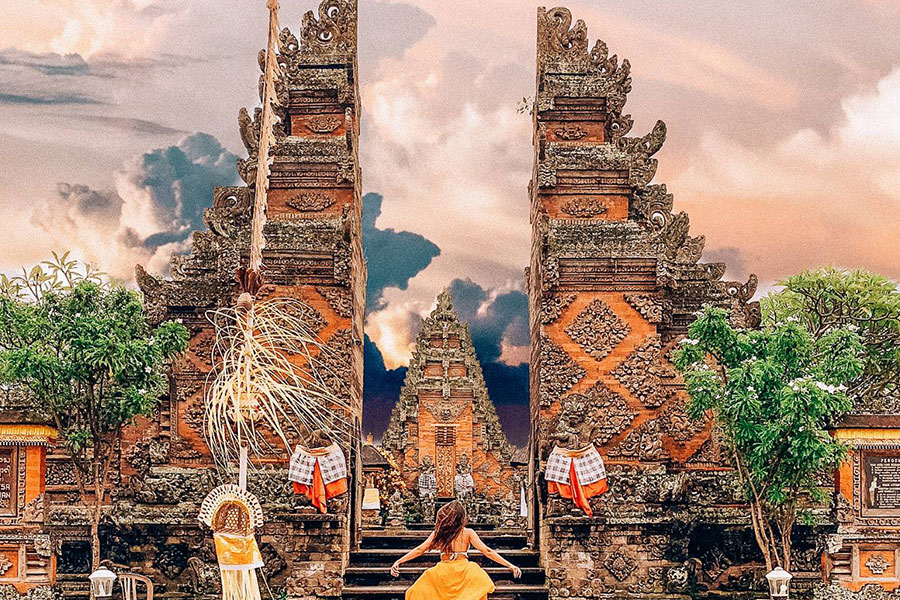BATUAN TEMPLE
BATUAN TEMPLE IS A VERY BEAUTIFUL TEMPLE AND PART OF THE TRI KAHYANGAN CONCEPT BY MPU KUTURAN IN ANCIENT TIMES

Batuan Temple, also known as Puseh Batuan Temple, is a local Balinese Hindu temple cared for by locals in the Batuan countryside. The temple has a very beautiful design with Balinese ornaments, and the roof of the temple is made of palm fiber (black-colored palm trees). Strategically located next to the main road from Denpasar to Ubud, Batuan Temple has been on the list of Gianyar places of interest as a center of arts and crafts for over a thousand years and is also filled with legends and mysterious stories. Because of its strategic location on the way to Ubud, many tourists stop at Batuan Temple to enjoy the beauty of this place. Its complete facilities make Batuan Temple one of the most frequently visited tourist destinations, and it is often included in tour programs when visiting Ubud Village.
If you visit Batuan Temple, here’s what you need to know:
- Batuan Temple Location
- Batuan Temple History
- Meaning Name of Batuan
- The Uniqueness of Batuan Village
- Geography of Batuan Temple
- Pre-Historic Relics at Batuan Temple
- Batuan Temple Dress Code
Batuan Temple Location
Batuan Temple is located in Batu Village, Ubud Sub-district, Gianyar Regency, which is easy to find as it is located on the main road to Ubud Village. Traveling from Kuta will probably take about 60-90 minutes, while from Ubud it is only about 30 minutes. You can use Google Maps for navigation assistance to avoid getting lost. If you want to make it easier, you can contact us at Bali Driver Hire for transportation and visits to Batuan Temple and other tourist destinations at affordable prices and satisfying services, also accompanied by experienced drivers to make your trip more enjoyable.
Batuan Temple History
Batuan Temple was founded in 944 Isaka (1020 AD) and is almost 1000 years old. Batuan Temple belongs to the category of Puseh Temple, which follows the concept of “Tri Kahyangan or Tri Murti” in accordance with the concept of Pakraman Village. This concept, including Tri Kahyangan Temple, was first proposed by Mpu Kuturan in 1001 AD, after his arrival on Bali Island. His goal was to unite the various sects and groups of people in Bali in the worship of God in the form of the gods Brahma, Vishnu, and Shiva (Tri Murti Tatwa). Batuan Temple is an example of the Tri Hita Kahyangan concept, where the Puseh Temple in Batuan Village is maintained and preserved by the local community. The concept of Tri Kahyangan, or Tri Murti, involves 3 temples.
- Desa Temple, or Village Temple, is a place of worship for Lord Brahma (the Creator).
- Puseh Temple is a place of worship for Lord Vishnu (the Sustainer).
- Dalem Temple is a place of worship for Lord Shiva (the Destroyer).
The arrival of Mpu Kuturan in Bali in the 1001st year was the beginning of the process of developing religious concepts such as the understanding of Tri Murti and Pura Kahyangan Tiga. Parum-paruman (meetings) were also held to bring together leaders from various groups, classes, and sects with the aim of uniting the diversity of sects that exist in Balinese society. This meeting place became known as Samuan Tiga Temple, which is located in Blahbatuh near the tourism center of Ubud in Gianyar.
Meaning Name of Batuan
The name “Batuan” or “Baturan” mentioned here makes villagers joke about being “as strong as a stone” or “eating a stone” because in Balinese, “batu” means ” stone”. However, in truth, the name most likely refers to ancient megalithic traditions where standing stones were used as meeting places and ceremonies to worship ancestral spirits. As Batuan became a center for the dispersal of Buddhist priests and brahmins to court centers in southern Bali, the village has an unusual number of brahmins. The local community pays great attention to the care and preservation of the temple architecture as well as the surrounding environment. Although not all the buildings here are of ancient origin, some have undergone renovation, renewal, and alteration from the 10th to 13th centuries, as well as the 18th century AD. The structure and foundation of this temple are very sturdy and strong, with beautiful Balinese ornaments adorning every building in the temple complex. Some of the ornaments depict stories from the Ramayana epic, and each sacred building has a different function philosophically.
The Uniqueness of Batuan Village
Batuan Village, apart from being the location of the very beautiful Batuan Temple, also offers other interesting tourist destinations. Here, you can find many talented painters of traditional paintings. Most of the local residents of Batuan Village are painters, and along the way to Batuan Temple, you will see many art galleries selling various types of paintings, ranging from traditional, modern, abstract, and more. You can also visit these establishments and see the process of making paintings that have become famous overseas. Batuan Village can be considered the center of painting art, in contrast to Celuk Village, which is famous as the center of silver and gold handicrafts. Although these two villages are located not so far from each other, they both have unique characteristics that often make them popular destinations for visitors.
Geography of Batuan Temple
Batuan Temple is always crowded with tourists because of its unique history and the beauty of its temple architecture, which is filled with Balinese carvings, making the scenery there even more stunning. When you visit Puseh Batuan Temple, it is important to know a little about the temple, especially the Batuan Temple area, which has three courtyards that are worth visiting.
- In the parking area of the temple, there is an ancient building called Wantilan that serves as a meeting place and practice of various Balinese dances such as Gambuh Dance, Pendet Dance, and others. Before entering the temple, the locals at Wantilan will lend you a kamben (traditional Balinese costume) as a sign of respect for the sanctity of the Puseh Temple of Batuan Village. The service is free, and there is no entrance fee. However, tourists are expected to make a donation according to their ability to support the maintenance of the temple. There is a simple donation box at your disposal. Donations should be made with sincerity, in keeping with the Balinese tradition of “medana punia”.
- In the central courtyard of the temple are two long buildings, or bales, Bale Agung and Bale Kulkul, which are built of wood or bamboo. In addition, the courtyard also has a tall Balinese arch, known as Kori Agung, which is adorned by giant guardian statues. The main function of Kori Agung is as an entrance and exit for the gods, represented by small statues called Pratima. Next to the Kori Agung are two small doors used by devotees to enter and exit the main temple grounds.
- In the main courtyard of Batuan Temple, there is a very holy place, the core temple of this temple. When you visit this courtyard, it is important to maintain a polite demeanor and not do anything untoward, as this area is highly sacred to the local community. Inside this temple, there are several three-story Meru and Bale Pengiyasan, which are the symbols of Besakih Temple. In addition, there is also a building called Padmasana, which is used as a place of worship for Sang Hyang Widhi, the god of Balinese Hindus.
Pre-Historic Relics at Batuan Temple
Batuan Temple not only has a strong spiritual vibe but is also a guardian of historical values. It contains many amazing ancient relics from prehistoric times. The influence of Hindu culture in Bali is reflected in the natural stones used in this temple as a place of worship, both for ancestors and revered Hindu gods. You will be impressed to see some ancient and unique statues there. Based on the statues found in this Puseh temple, they can be grouped into several types, including Dwarapala statues, embodiment statues, animal statues, statues holding chickens, phalluses, demons (time), and others. These relics reveal that Batuan Temple has been established since ancient times, making it one of the oldest temples on Bali Island.
Batuan Temple Dress Code
The dress code at Batuan Temple requires visitors to wear modest clothing. At the Wantilan, near the parking lot, there is an attendant who rents out sarongs and scarves to enter the temple. You can rent the sarong and shawl to honor this sacred place. The temple is a sacred place for Hindus, and visitors are required to wear traditional Balinese clothing, such as sarongs and scarves, to enter. If you need a sarong and shawl, you don’t need to worry, as the facilities are available there. After entering the temple, you can take photos with the enchanting background of Batuan Temple. Batuan Temple is well maintained by the surrounding community. Therefore, it is expected that visitors can maintain a polite and courteous attitude while in the temple area. Enjoy the beauty of Batuan Temple, one of the oldest and most beautiful temples in Bali.

